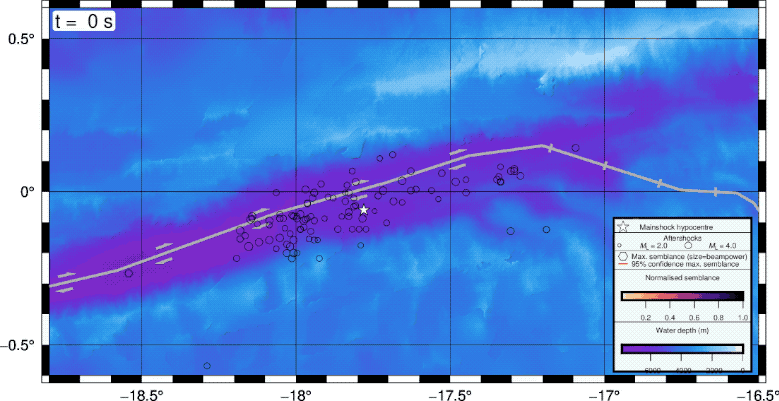Weird 'boomerang' earthquake recorded for the first time

A massive earthquake in the middle of the Atlantic Ocean in 2016 ricocheted east then west like a geologic boomerang.
Boomerang quakes have only been rarely anecdotally reported, and never before recorded scientifically. This strangely complex earthquake happened on a relatively simple, straight-line fault called an ocean transform fault. That suggests such weird, ricocheting quakes could happen on other straight-line faults, such as the San Andreas Fault that snakes along California's coast.
Complicated earthquakes aren't unusual, said study co-author Stephen Hicks, an earthquake seismologist and research associate at Imperial College London. But that's not surprising because most faults are complicated: They might be very close to other faults, which all rupture in weird ways when one snaps under pressure. Ocean transform faults, by contrast, should be simple, Hicks said.
"We're seeing this level of complexity on just a single structure," Hicks told Live Science.
Related: 10 ways Earth revealed its weirdness in 2019
Normally, ocean transform faults pose little danger to humans. They're far out in the ocean, for one thing, and their motion is all horizontal, so when they rupture, they don't cause tsunamis. But understanding these faults is important because transform faults like the San Andreas (SA) also exist on land, Hicks said..
"Understanding how these ocean transform faults work might give us some information on how more complex faults such as the SA fault might work," Hicks said.
Sign up for the Live Science daily newsletter now
Get the world’s most fascinating discoveries delivered straight to your inbox.
Transform faults
Ocean transform faults sit along oceanic ridges that are pulling apart. The faults form because some segments of the oceanic ridge pull apart faster than other segments, leading to straight-line cracks perpendicular to the line of new crust that forms in these spreading zones. On the topography of the seafloor, they stand out, looking a bit like the teeth on the zipper of the spreading zone.
Big earthquakes happen relatively frequently on these faults, perhaps every 20 to 50 years, Hicks said. He and his team were lucky enough to observe one with ocean-bottom seismometers that had been deployed for a different research project. The magnitude-7.1 quake rumbled along the Romanche Spreading Zone in the Atlantic Ocean, near the equator in August 2016. The zone is 571 miles (920 kilometers) long and has seen 13 earthquakes of magnitude 6.5 or more since 1970.
Related: Photo journal: The gorgeous San Andreas Fault
The seismic waves during the 2016 quake told a strange story. About 10 seconds after the first rupture at the epicenter, a section of the fault cracked nearly 25 miles (40 km) to the east of the epicenter. Then, after another 10 seconds, a patch of fault started rupturing again back at the epicenter.
"That was kind of weird," Hicks said. "If you think about this as a continuously propagating crack, it seems to have gone east after initiation and then it seems to have gone back west."

Boomerang quake
There are a few different reasons that a boomerang quake could have happened, Hicks and his colleagues reported on Aug. 10 in the journal Nature Geoscience. It's possible that the first rupture toward the east happened deep within the crust, which then built up energy and forced the re-rupture back toward the west at a shallower depth.
Alternatively, the energy of the quake may have bounced off the end of the fault, so to speak. The eastern rupture occurred at the far end of the fault, so perhaps some of the energy from the rupture zinged back through the fault.
"Maybe it still had this pent-up energy but couldn't get any farther east," Hicks said.
Another possibility is that ocean transform faults are messier than they appear. Faults, especially old faults that have moved a lot, are almost never single cracks in the crust, Hicks said. They're more like a wide, mushy zone. The transform fault that ruptured during the 2016 quake looks quite wide on the ocean surface, Hicks said. If it's similarly broad all the way into the crust, computer models of earthquakes suggest that a boomerang quake is possible. That's because a wide fault zone has many parallel zones of weakness that can trigger movement in one another, Hicks said.
No one has ever described a boomerang-type earthquake in the scientific literature before, Hicks said, though there is one anecdotal report of someone witnessing a surface crack going in the opposite direction from the recorded seismic waves in Baja California, Mexico, in 2010. The second-by-second movement in any earthquake is often complicated, he said, but understanding that movement could gradually lead to an understanding of how and why earthquakes begin.
"We can't predict earthquakes because we don't know exactly what goes on along a fault during earthquakes," Hicks said. "Every earthquake we analyze surprises us in some ways."
Originally published on Live Science.

Stephanie Pappas is a contributing writer for Live Science, covering topics ranging from geoscience to archaeology to the human brain and behavior. She was previously a senior writer for Live Science but is now a freelancer based in Denver, Colorado, and regularly contributes to Scientific American and The Monitor, the monthly magazine of the American Psychological Association. Stephanie received a bachelor's degree in psychology from the University of South Carolina and a graduate certificate in science communication from the University of California, Santa Cruz.










